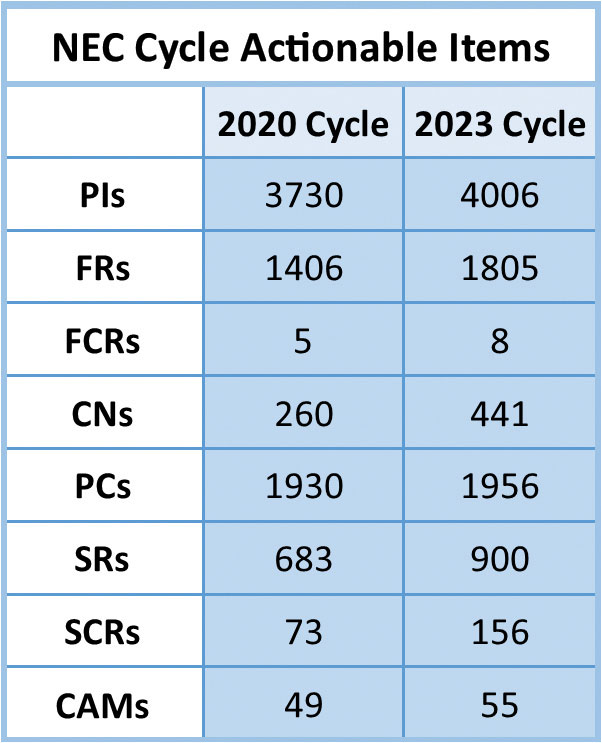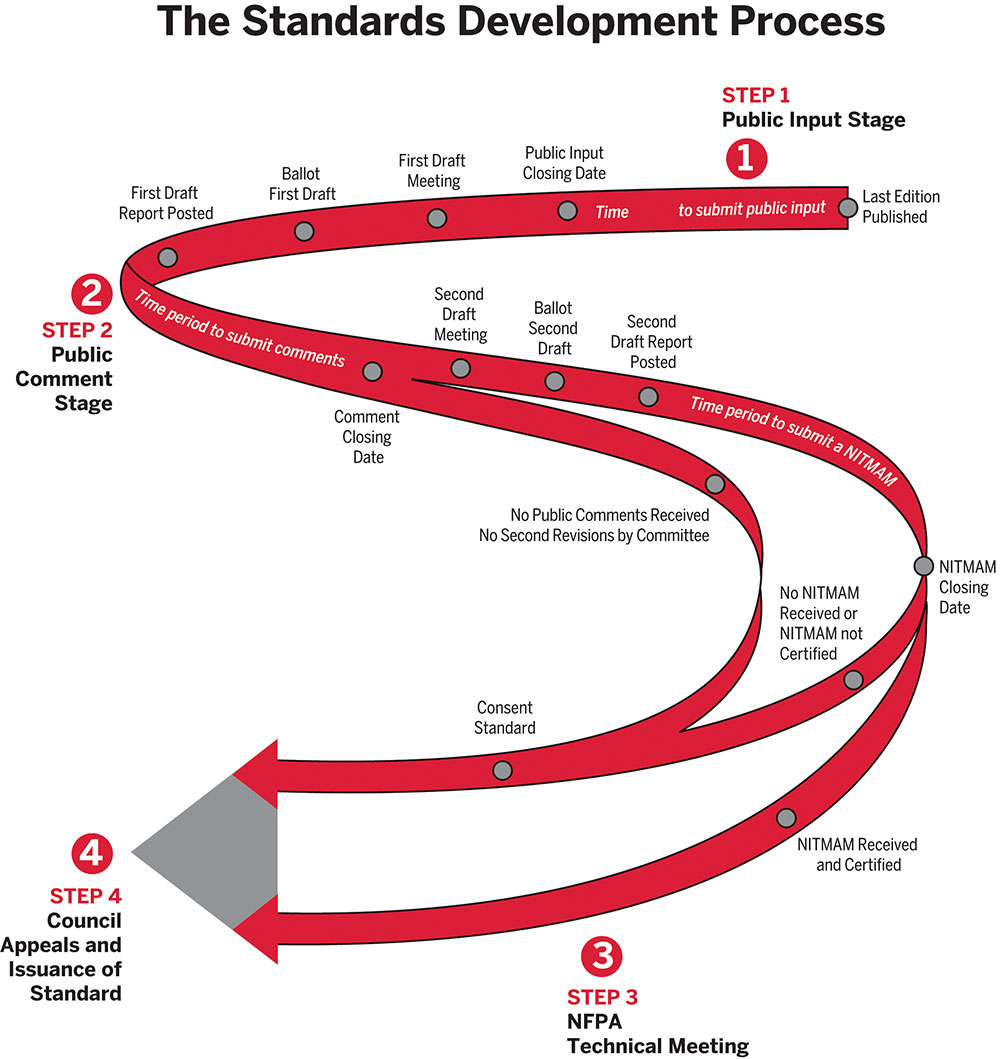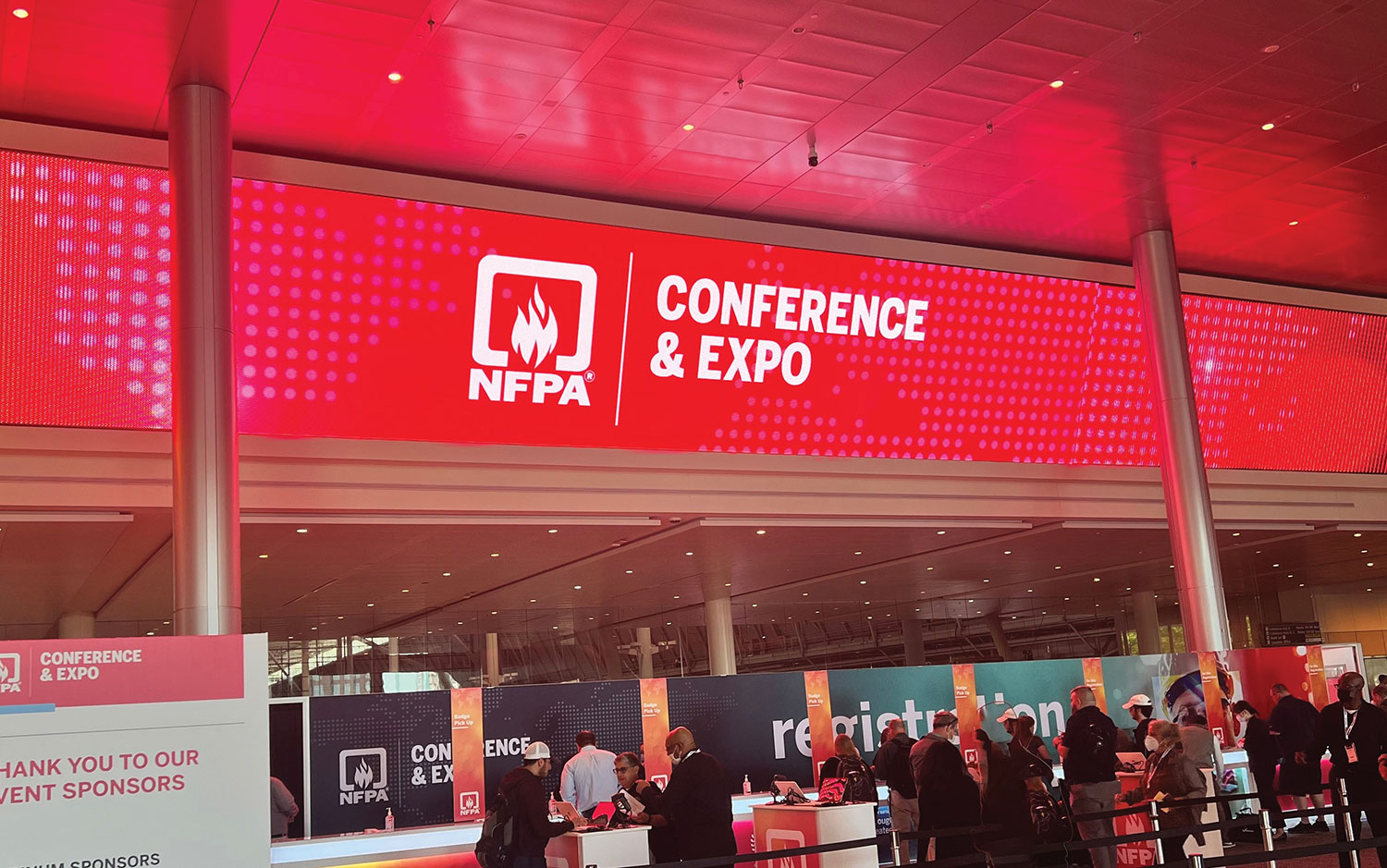After a nearly three-year process, the ink is almost ready to dry on the 2023 NFPA 70® National Electrical Code® (NEC)®. This cycle of the NEC has been like no other. The COVID-19 pandemic turned everyone’s world upside down beginning in the Spring of 2020, and the NEC was no exception. While the NFPA Standards Development Process stayed tried and true as the foundation for building the 2023 NEC, the normal face-to-face committee meetings could not be held because of social distancing requirements and to ensure the personal safety of our committee members and NFPA staff. Knowing that we must forge ahead continuing to improve upon electrical safety, 18 code making panels (CMPs), made up of countless volunteer members, and NFPA staff moved ahead with the 2023 NEC development by using virtual meetings. Even though the pandemic influenced how we went about meeting to develop the NEC, the hard work and diligence of the CMP members and NFPA staff made sure that this imperative work was not only done but done on schedule.
No Slowing Down
In November 2019, shortly after the 2020 NEC was first issued, the public input (PI) stage for the 2023 NEC opened. Roughly six months of “normal” elapsed until the pandemic reared its unwanted head. Considering this timing, that means that nearly 85 percent of the development of the 2023 NEC was handled during the pandemic. That may lead a person to believe that COVID-19 probably slowed down the whole NEC development process overall, but that could not be further from the truth. Every actionable area of the 2023 NEC development process was actually an increase over the same categories during the 2020 NEC development, those key areas being: Public Inputs (PIs), First Revisions (FRs), First Correlating Revisions (FCRs), Correlating Notes (CNs), Public Comments (PCs), Second Revisions (SRs), Second Correlating Revisions (SCRs), and Certified Amending Motions (CAMs).

Speaking of CAMs, there were 55 CAMs prepared on the NEC to be heard at the Technical Meeting on June 9th in Boston at the 2022 NFPA Conference & Expo. Of those CAMs, 18 passed, 23 failed, and 14 were not pursued, often based on the CAM being pulled due to a related CAM heard previously not passing. To see the Technical Meeting take place and CAMs being introduced truly shines a light on the overall depth and engagement of the NFPA Standards Development Process. Passionate NFPA members debate the proposed changes to the NEC, until it is eventually put to a vote of all members present. All members present that have been members for at least 180 days are eligible to cast their vote. Some of the votes can be extremely close. For example, CAM 70-126, which dealt with the minimum size copper-clad aluminum branch-circuit conductors, failed by an extremely narrow margin of 196 votes in favor of the CAM and 198 votes against.

Still to Come
For CAMs that failed to get the necessary passing votes, the Technical Meeting doesn’t necessarily have to be the end of the road. Per section 1.6.2(a) of the Regulations Governing the Development of NFPA Standards, anyone who is dissatisfied with the results of the CAM can submit an appeal to the NFPA Standards Council, as long as it is submitted within 20 days of the closing of the Technical Meeting. When the Standards Council meets August 10-12 in Quincy, MA, they will hear any submitted appeals. Once those decisions are rendered, the Standards Council will consider and make a final determination on the issuance of the 2023 edition of the NEC.
When you first pick up your copy of the 2023 NEC, or view it online at NFPA LiNK™, it may look a little different at first glance. Many changes were made around usability and alignment with the 2020 National Electrical Code® Style Manual, which was amended in December 2020. The NEC Style Manual provides the editorial and administrative requirements for both the NEC as well as NFPA 70E® Standard for Electrical Safety in the Workplace®. Stated clearly within the purpose, the NEC Style Manual is intended to be used as a practical working tool to assist in making the documents as clear, usable, and unambiguous as possible. Because the most recent NEC Style Manual was issued after the release of the 2020 NEC, this cycle presented the first opportunity to align the NEC with the updated requirements. A significant pending change to the 2023 NEC driven by the NEC Style Manual is moving all definitions from the individual NEC Articles into Article 100 Definitions. Many of the “Informational Notes” throughout the NEC have also been modified to consistently align with the NEC Style Manual requirements.
No code cycle ever passes by without proposed changes being made around ground-fault circuit interrupters (GFCIs) and arc-fault circuit interrupters (AFCIs), and this cycle included several. But the proposed changes to the 2023 NEC also delve into newer technologies and items we haven’t seen addressed before within the NEC. Some examples include:
- Cybersecurity
- Cannabis extraction
- Wireless power transfer
- Photovoltaic (PV) installations on bodies of water
- Fault-managed power
Always looking to improve upon electrical safety, each new version of the NEC never reads as the one before it did. Through a transparent development process that relies on public input, proposed changes make their way through the process and possibly become printed words on the page. While the COVID-19 pandemic brought about new challenges to development of the 2023 NEC, the effort of the public to bring about change and the steadfast work of the CMP members and NFPA staff members has us just steps away from a newly completed cycle of the NEC. The commitment and determination of all parties involved should be commended. Although the making of the 2023 NEC was unique, what will be common is the NEC continuing to be the world’s most utilized code to keep people and property safe when it comes to electricity.
Pre-order for both the 2023 NEC Softbound and 2023 NEC Handbook is now available. For more information around swimming pool electrical safety, please visit the NFPA® Swimming Pools, Hot Tubs, and Spas page.
Important Notice: Any opinion expressed in this column is the personal opinion of the author and does not necessarily represent the official position of NFPA or its Technical Committees. In addition, this piece is neither intended, nor should it be relied upon, to provide professional consultation or services.











Find Us on Socials